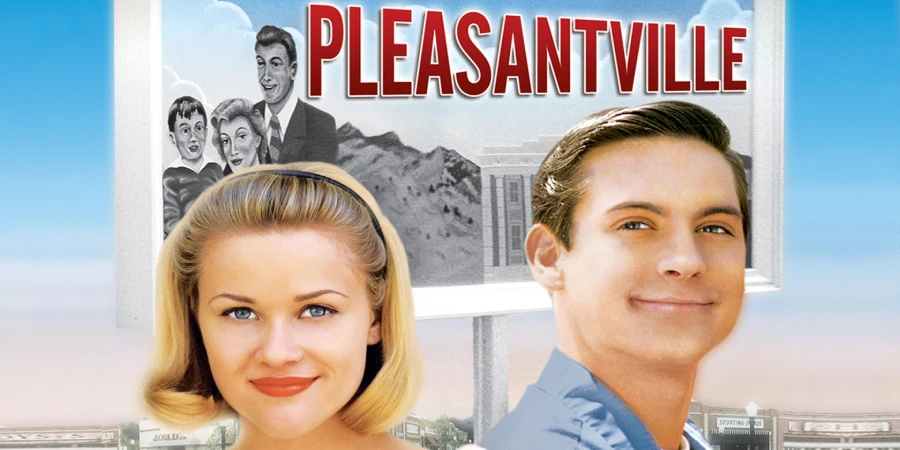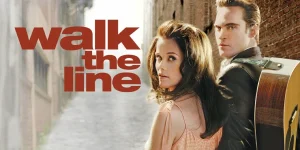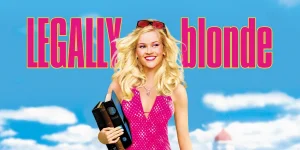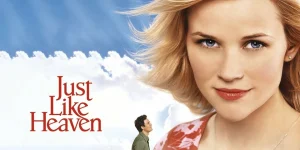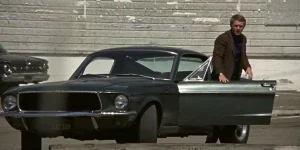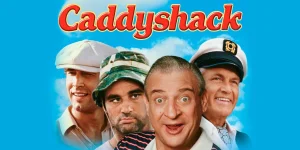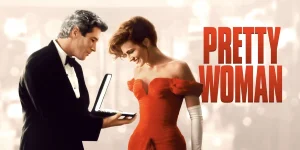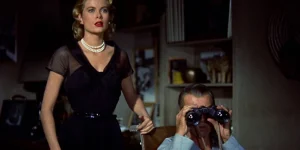Pleasantville is a 1998 fantasy-drama film directed by Gary Ross, offering a deeply philosophical and visually striking tale of transformation—both personal and societal. Through its clever narrative device of two 1990s teenagers trapped in a 1950s TV show, the film explores themes of repression, conformity, awakening, and change, blending satire, nostalgia, and allegory in a unique cinematic experience.
Table of Contents
ToggleDetailed Summary
Introduction: A Tale of Two Siblings
David (Tobey Maguire) and Jennifer (Reese Witherspoon) are teenage siblings living in the 1990s. David is obsessed with Pleasantville, a black-and-white 1950s TV sitcom about a perfectly wholesome American town. Jennifer, on the other hand, is more concerned with popularity, dating, and the modern teenage lifestyle.
During an argument over the remote control, the TV breaks. A mysterious repairman (Don Knotts) shows up and offers them a magical remote. When they use it, they are suddenly transported into the Pleasantville TV show, becoming characters Bud and Mary Sue.
Welcome to Pleasantville
The town of Pleasantville is portrayed in black and white, reflecting its limited worldview—everything is clean, controlled, and seemingly perfect. The characters in the town don’t know about things like sex, rain, fire, or change. They are trapped in their own sanitized routines.
David, now Bud, tries to play along and “stay in character,” while Jennifer (Mary Sue) starts introducing modern ideas to the town—starting with sex. This begins to cause color to appear in the world: people, objects, and eventually entire locations begin turning from grayscale to vivid color when they experience emotional, intellectual, or sensual awakenings.
The Awakening and Its Consequences
As more townspeople become “colored,” tensions rise. Those still in black and white start seeing the changes as a threat to their way of life. This leads to social unrest, book burnings, and even acts of violence. Gary Ross uses this growing divide to mirror historical (and ongoing) civil rights struggles, McCarthyism, and the fear of progress.
David encourages people to read, think, and feel, which causes even more to “awaken.” Jennifer, ironically, starts becoming more intellectual, reading literature for the first time and considering college.
Bud helps Mr. Johnson (Jeff Daniels), a soda jerk turned artist, discover painting. This becomes one of the key turning points—art, passion, and independent thought spread rapidly, especially among the youth.
The Rebellion and Showdown
The “colored” citizens are segregated. Laws are enacted against “coloreds,” books are banned, and shops are destroyed in a Kristallnacht-like riot. David gives a courtroom speech, standing up against the conformist leadership of the town. This public stand causes the judge and others to turn color as well—showing that even the defenders of the old way are not immune to emotion and change.
Movie Ending
In the final scenes, color fully envelops Pleasantville, symbolizing the complete transformation of the town and its people. David (Bud) reconciles with his new identity and experience. Jennifer (Mary Sue), surprisingly, chooses to stay behind—not in Pleasantville, but in the modern 1990s, having matured and chosen a new, more grounded path. She plans to go to college, showing personal growth.
David, now far more confident and emotionally mature, returns to the real world. He interacts with his mother, who is going through a divorce, with a newfound empathy and calm. The transformation he underwent in Pleasantville has given him the emotional tools he lacked before.
The movie ends on a poignant note: in Pleasantville, George (the father, played by William H. Macy) sits on a bench with his wife, Betty (Joan Allen), who has also turned color and embraced change. He turns to Mr. Johnson and says, “So… what happens now?” Mr. Johnson simply replies, “I don’t know,” and the two switch places in the same conversation. It’s a moment that encapsulates the uncertainty, freedom, and hope that come with change—perhaps the film’s most resonant message.
There is no post-credits scene in Pleasantville. The film ends definitively, with its final message delivered through this simple yet profound exchange.
Type of Movie
Pleasantville is a fantasy drama with satirical and allegorical elements. It also functions as a coming-of-age story, a social commentary, and a love letter to cinema itself.
Cast
- Tobey Maguire as David / Bud
- Reese Witherspoon as Jennifer / Mary Sue
- Joan Allen as Betty Parker
- William H. Macy as George Parker
- Jeff Daniels as Bill Johnson
- J.T. Walsh as Mayor Big Bob
- Don Knotts as The TV Repairman
- Marley Shelton as Margaret
Film Music and Composer
The film’s original score was composed by Randy Newman, known for blending whimsical, emotional, and Americana-infused melodies. The soundtrack features a mix of 1950s classics and modern songs to underline the collision of two eras. Songs like Fiona Apple’s cover of “Across the Universe” capture the film’s themes beautifully.
Filming Locations
Pleasantville was primarily shot on sets at Warner Bros. Studios in Burbank, California, using the same backlot streets used in Leave It to Beaver and other classic shows. The location was crucial to evoke the artificial perfection of 1950s suburbia, and the use of digital color grading to transform parts of the set was groundbreaking at the time.
Awards and Nominations
- Nominated for 3 Academy Awards:
- Best Art Direction
- Best Costume Design
- Best Original Score (Randy Newman)
- Won several Saturn Awards, Los Angeles Film Critics Association Awards, and Satellite Awards, particularly for technical achievements in visual effects and set design.
Behind the Scenes Insights
- The film was one of the first major Hollywood productions to use extensive digital color effects. Over 1,700 visual effects shots were created.
- Joan Allen reportedly found it emotionally intense to act in black-and-white makeup while conveying deep emotion.
- The courtroom scene was inspired by To Kill a Mockingbird.
- Director Gary Ross had the actors play their scenes in grayscale lighting to help them stay in character.
- Reese Witherspoon was cast partly because of her comedic timing and “modern edge.”
Inspirations and References
- The movie was inspired by 1950s television, particularly shows like Father Knows Best and Leave It to Beaver.
- The narrative borrows elements from Ray Bradbury, George Orwell, and Harper Lee in its critique of conformity and fear of change.
- The visual shift from black-and-white to color recalls The Wizard of Oz.
Alternate Endings and Deleted Scenes
There were no widely known alternate endings, but several deleted scenes focused on expanding side characters’ stories—such as longer subplots involving the high school students and more of Betty’s inner transformation.
Book Adaptations and Differences
The movie is not based on a book, but its literary tone and layered allegory have led many to compare it to classic dystopian novels and social satire.
Memorable Scenes and Quotes
Key Scenes
- Jennifer seducing her boyfriend in Lovers’ Lane, causing the first appearance of color.
- David helping his mother discover her identity through the simple act of applying makeup.
- Mr. Johnson painting a nude portrait of Betty.
- The courtroom showdown where David stands against censorship and repression.
- The fire at the tree—Pleasantville’s first taste of natural chaos.
Iconic Quotes
- “There are some places where the road doesn’t go in a circle. There are some places where it keeps on going.”
- “It’s not supposed to be like this.” – George Parker
- “You can’t stop something just because you don’t understand it.”
- “You don’t have to stay inside the lines.”
Easter Eggs and Hidden Details
- The books in Pleasantville are initially blank until someone starts thinking for themselves—symbolizing intellectual awakening.
- The soda shop has identical orders every day until David breaks the routine.
- All television screens display perfect images—until someone deviates from the script.
- Bud’s real name, David, hints at the biblical David vs. Goliath battle—he is the challenger of the system.
Trivia
- Gary Ross also wrote Big (1988) and later directed Seabiscuit and The Hunger Games.
- The visual effects used to isolate color were revolutionary and influenced many later films.
- Joan Allen won multiple critics’ awards for her performance, despite not being nominated for an Oscar.
- The courtroom scene mirrors real-life historical trials about censorship and civil rights.
Why Watch?
Pleasantville is more than just a clever fantasy—it’s a deeply emotional, thoughtful exploration of growth, individuality, repression, and liberation. It’s ideal for those who enjoy character-driven narratives with rich metaphors and social critique, especially wrapped in stylish, visually inventive filmmaking.
Director’s Other Movies
- Seabiscuit (2003)
- The Hunger Games (2012)
- Free State of Jones (2016)
- Big (1988) – screenwriter
- Dave (1993) – screenwriter

